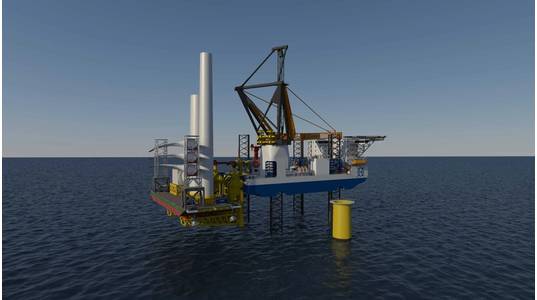
Offshore wind in the United States is moving forward at pace, thanks in large part to a number of positive developments for the newly emerging industry over the last year or so. For one, the Biden administration at the start of 2021 revealed its aim to have 30 gigawatts (GW) of offshore wind power in development by 2030 and 110 GW by 2050. Those are some big numbers, and the industry is now getting in gear to produce.
It will take a large number of vessels to help build up to reach these targets, including both U.S.- and foreign-flagged tonnage. While it is true that the Jones Act applies to U.S. offshore wind, it is expected that the industry will rely mostly on foreign flagged wind turbine installation vessels (WTIV) working in combination with a fleet of American-built and -crewed feeder assets (such as tugs and barges, or potentially even specially designed ship-shaped feeder vessels) that will transport turbine components from the U.S. mainland for installation offshore.
A Houston-based naval architecture and marine engineering firm with decades of experience in both maritime and offshore oil and gas has come up with a solution engineered to make this process safer and more efficient. Friede & Goldman’s (F&G) BargeRack system—patent pending—uses a trussed rack fitted to the transom of a self-elevating vessel to lift feeder barges out of the water, thereby eliminating motions between the installation vessel and the barge while lifting and installing wind turbine components.
“Operators don't want to lift turbine components off of a moving feeder vessel. We've solved that problem by lifting the entire vessel out of the water to completely eliminate the motions,” explained Robert Clague, F&G’s vice president of engineering.
The BargeRack uses its own rack and pinion jacking system to lower vertically from the WTIV or jack-up into the water. A feeder barge loaded with turbine components is floated over the submerged rack and secured. Then, the self-elevating installation vessel uses its onboard jacking system to elevate, while also lifting the rack, and therefore the feeder barge and its cargo, out of the water entirely. From this position, the main crane installs the turbine components directly from the stationary barge onto the turbine foundation. After turbine installation, the self-elevating unit jacks down to submerge the rack and refloat the empty feeder barge.
In addition to eliminating the barge motion, Clague noted another advantage of the system is that the rack can load the barge even after the jack-up is already raised out of the water, reducing wear and tear on the leg/hull interface. “On a jack-up, once the legs are engaged with the seabed, you want to preload and get the hull out of the water as soon as possible,” Clague said. “Once the legs touch bottom, even the minimal environment on the hull—waves and current—place wear and tear on the legs, guides, jacking system, etc. - because all of that load from the hull travels through the leg/hull interface down to the seabed. With our solution, we’re able to quickly go through the entire preloading of the leg footings and get to our minimal air gap before bringing the feeder on. Then, the rack is deployed, the feeder comes on and we elevate the barge.”
The solution, while initially created for relatively small jack-ups in the U.S. that would not transport wind turbines due to Jones Act restrictions, has also been tailored for use on larger WTIVs that could potentially operate internationally as well. "The rack easily comes on and off the vessel. The owner puts this removable rack on the vessel, and it operates in the U.S. as part of a feeder solution. And then, if the vessel gets a different contract outside of the U.S., those feeder racks can be taken off.”
The BargeRack has been engineered to be installed on newbuilds or retrofitted, whether on F&G’s designs or others. F&G’s latest iteration is designed to lift a barge of sufficient size and capability to transport 20 megawatt (MW) turbines. Clague said the company has been working with turbine vendors, crane manufacturers and even barge builders to “future-proof” its designs.
A WTIV designed with the BargeRack system was recently granted approval in principle (AIP) from the American Bureau of Shipping (ABS). According to Clague, this “gives owners more confidence that there's no show-stoppers, that the technology is feasible and practical.”
F&G has been presenting its BargeRack to the market with hopes of cashing in as the U.S. offshore wind industry ramps up. “We see a big opportunity for feeder solutions, given (a) the cost of a Jones-Act-compliant installation vessel, and (b) the infrastructure challenges in the U.S.; both of those things point toward the feeder solution, Clague said. “We've done the design, we've filed for the patent, and we think we have the best feeder solution. Now it's just a matter of partnering up with the field developer and the vessel owner and the logistics companies.”